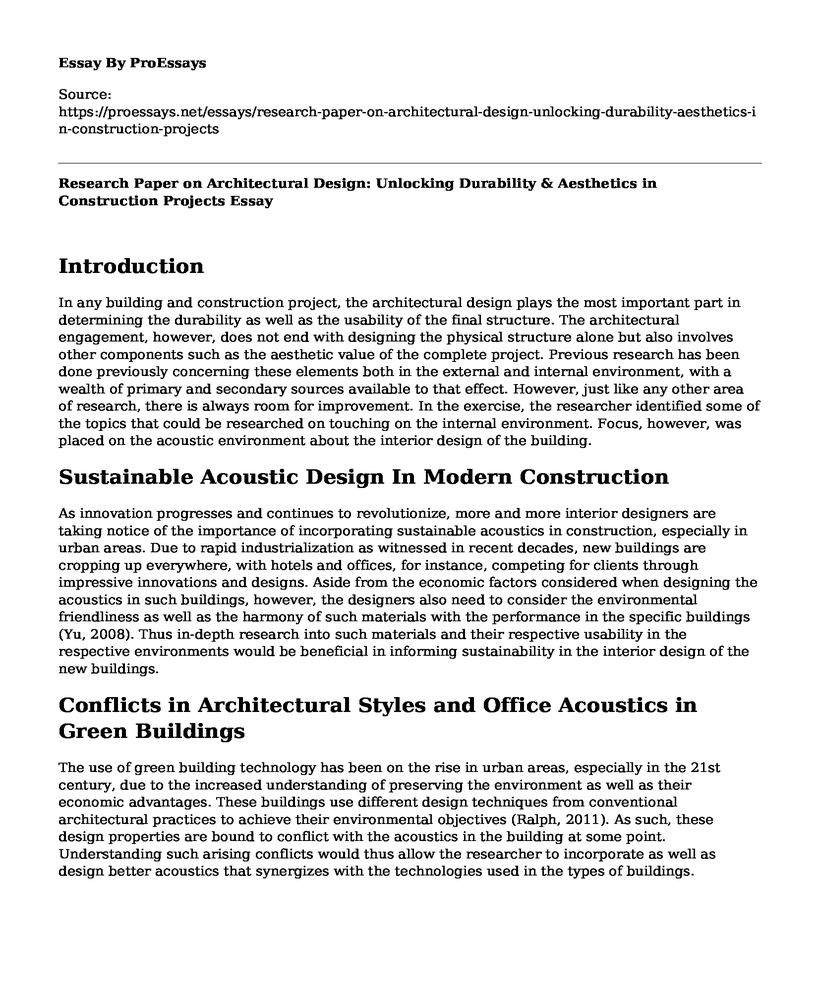Introduction
In any building and construction project, the architectural design plays the most important part in determining the durability as well as the usability of the final structure. The architectural engagement, however, does not end with designing the physical structure alone but also involves other components such as the aesthetic value of the complete project. Previous research has been done previously concerning these elements both in the external and internal environment, with a wealth of primary and secondary sources available to that effect. However, just like any other area of research, there is always room for improvement. In the exercise, the researcher identified some of the topics that could be researched on touching on the internal environment. Focus, however, was placed on the acoustic environment about the interior design of the building.
Sustainable Acoustic Design In Modern Construction
As innovation progresses and continues to revolutionize, more and more interior designers are taking notice of the importance of incorporating sustainable acoustics in construction, especially in urban areas. Due to rapid industrialization as witnessed in recent decades, new buildings are cropping up everywhere, with hotels and offices, for instance, competing for clients through impressive innovations and designs. Aside from the economic factors considered when designing the acoustics in such buildings, however, the designers also need to consider the environmental friendliness as well as the harmony of such materials with the performance in the specific buildings (Yu, 2008). Thus in-depth research into such materials and their respective usability in the respective environments would be beneficial in informing sustainability in the interior design of the new buildings.
Conflicts in Architectural Styles and Office Acoustics in Green Buildings
The use of green building technology has been on the rise in urban areas, especially in the 21st century, due to the increased understanding of preserving the environment as well as their economic advantages. These buildings use different design techniques from conventional architectural practices to achieve their environmental objectives (Ralph, 2011). As such, these design properties are bound to conflict with the acoustics in the building at some point. Understanding such arising conflicts would thus allow the researcher to incorporate as well as design better acoustics that synergizes with the technologies used in the types of buildings.
Optimization of Noise Control with the Finishing Materials in Interior Design
Urban areas increasingly experience higher and higher acoustic loads, especially with the changes in technology witnessed in recent years as well as the continuing industrialization (Asdrubali, 2006). As a result of this, new and sophisticated construction materials with complex geometric designs have cropped up to optimize these properties (Fiala et al., 2017). Research into these new materials has been limited so far, given the relative newness of the technologies used. These materials include walling bricks, floor, ceiling as well as roofing finishes. Thus further research into the nature of these new materials, as well as their harmonization, would enable the researcher to understand the means to incorporate them with traditional acoustic techniques and materials for maximum efficiency.
Harmonization of Aesthetic Value and Acoustics in Urban Buildings
Urban buildings have the most requirements when it comes to aesthetics and acoustic properties, as discussed earlier. The necessity to have the best aesthetics for such buildings could thus complicate the designs for acoustic performance in the interior architecture (Rilo et al., 2002). Hotels and office buildings close to airports, for instance, create a challenge in this aspect as the acoustic properties required for such places are greater than other similar constructions (Brown et al., 2015). Research into new methods of incorporating these acoustic materials with low-cost materials such as doors and windows would go a long way in promoting comfort for the customers and other occupants in such premises.
Acoustics Materials Impact on the Environment
Acoustic materials for both traditional and green buildings come in different forms and shapes. Their impact on both the external and internal environment thus varies a lot, depending on the nature of their use and installation in the building design. These materials also serve different purposes in the areas they are installed and thus require adequate research about the preference in a particular area (Allison, 2019). Gaining in-depth information and knowledge as to the preferences would be beneficial to the researcher in determining the most suitable materials for the area as well as developing a method of examining the sounds present in the area and consequently the use of environmentally sustainable acoustics.
References
Allison, M. (2019). Acoustics: The Sounds of Sustainable Design. [online] Green Building News. Available at: http://greenbuildingnews.com/2015/05/20/acoustics-the-sounds-sustainable-design/ [Accessed 27 Oct. 2019]. (Allison, 2019)
Asdrubali, Francesco. (2006). Green and sustainable materials for noise control in buildings. Retrieved from: www.researchgate.net/publication/258226060_Green_and_sustainable_materials_for_noise_control_in_buildings/Brown, Lex & Gjestland, Truls & Dubois, Daniele. (2015). Acoustic Environments and Soundscapes. 10.1201/b19145-2.
Familari, Nicholas. (2015). Designing rooms with perfect acoustical properties. 10.13140/RG.2.1.5036.1769.
Fiala, Lukas & Cerny, Robert. (2017). Theoretical approach to determination of acoustic properties of building materials. Retrieved from; https://www.researchgate.net/publication/320244595_Theoretical_approach_to_determination_of_acoustic_properties_of_building_materials/citation/downloadMuehleisen, Ralph. (2011). Acoustics of green buildings. The Journal of the Acoustical Society of America. 130. 2350. 10.1121/1.3654413.
Rilo, E., Cabeza, O., Dafonte, P., & Lorenzana, M. T. (2002). ACOUSTIC CHARACTERISTICS OF DIFFERENT MATERIALS USED IN CONSTRUCTION. In Forum Acusticum Sevilla 2002, paper MAT-01-01 (Vol. 5).
Yu, C. J. (2008). Environmentally sustainable acoustics in urban residential areas (Doctoral dissertation, University of Sheffield).
Cite this page
Research Paper on Architectural Design: Unlocking Durability & Aesthetics in Construction Projects. (2023, Feb 27). Retrieved from https://proessays.net/essays/research-paper-on-architectural-design-unlocking-durability-aesthetics-in-construction-projects
If you are the original author of this essay and no longer wish to have it published on the ProEssays website, please click below to request its removal:
- Crime Prevention Through Environmental Design Essay
- Left Wing Media Bias Essay Example
- Critical Essay on Humor in the "Wedding Ringer"
- Article Analysis Essay on Teachers, Social Media, and Free Speech
- Social Media and Social Development Paper Example
- Essay Sample on Evolution of Poetry Through the Centuries
- Essay Example on Ancient Greek Letter Writing: Paul's Epistles







